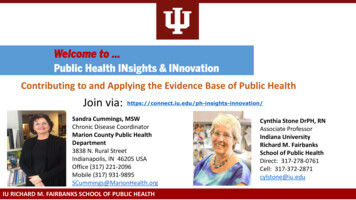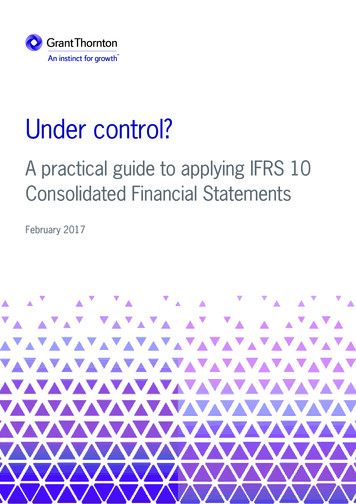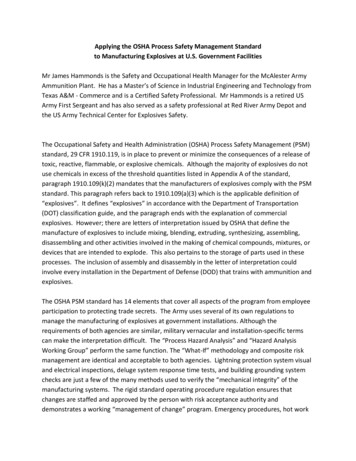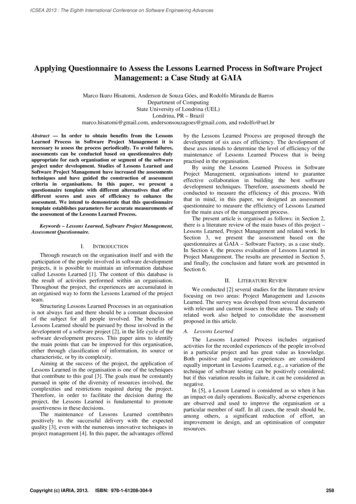
Transcription
Contributing to and Applying the Evidence Base of Public HealthJoin Sandra Cummings, MSWChronic Disease CoordinatorMarion County Public HealthDepartment3838 N. Rural StreetIndianapolis, IN 46205 USAOffice (317) 221-2096Mobile (317) 931-9895SCummings@MarionHealth.orgIU RICHARD M. FAIRBANKS SCHOOL OF PUBLIC HEALTHCynthia Stone DrPH, RNAssociate ProfessorIndiana UniversityRichard M. FairbanksSchool of Public HealthDirect: 317-278-0761Cell: 1317-372-2871cylstone@iu.edu
Objectives for Domain 10 – Contributing to and Applyingthe Evidence Base of Public HealthParticipants will be able to 1) identify and use the best available evidence formaking informed public health practice decisions, and 2) promote understandingand use of the current body of research results, evaluations, and evidence basedpractices with appropriate audiences.National Public Health Accreditation Board Standards and Measures, Version IU RICHARD M. FAIRBANKS SCHOOL OF PUBLIC HEALTHIU RICHARD M. FAIRBANKS SCHOOL OF PUBLIC HEALTH
STANDARD 10.1: Identify and use the best availableevidence for making informed public health practicedecisions.Measure 10.1.1 A Applicable evidence based and/or promisingpractices identified and used when implementing new or revisedprocesses, programs, and/or interventionsMeasure 10.1.2 T/S Fostered innovation in practice and researchIU RICHARD M. FAIRBANKS SCHOOL OF PUBLIC HEALTH
STANDARD 10.2: Promote understanding and use of thecurrent body of research results, evaluations, and evidencebased practices with appropriate audiences.Measure 10.2.1 A Protection of human subjects when the health department is involvedin or supports research activitiesMeasure 10.2.2 A Access to expertise to analyze current research and its public healthimplicationsMeasure 10.2.3 A Communicated research findings, including public health implicationsMeasure 10.2.4 S Consultation or technical assistance provided to Tribal and local healthdepartments and other public health system partners in applying relevant researchresults, evidence-based and/or promising practicesMeasure 10.2.4 T Technical assistance provided to the state health department, localhealth departments, and other public health system partners in applying relevantresearch results, evidence-based and/ or promising practicesIU RICHARD M. FAIRBANKS SCHOOL OF PUBLIC HEALTH
Domain 10: Contribute to andApply the Evidence Base of PublicHealthCynthia Stone DrPH, RNJanuary 29, 2016
Outline What is Domain 10?What is evidence based public health?What are resources to use to meet Domain 10?Examples of Domain 10
Domain 10: Contribute to and Apply the EvidenceBase of PH Standard 10.1 Identify and Use the Best AvailableEvidence for Making Informed Public Health PracticeDecisions Provide 2 examples from programs in different areasone must address chronic disease or preventing chronicdisease
Domain 1.1.1b. Describe how the evidence-based or promising practice wasidentified and incorporated into the design or re-design of theprogram
What is evidence based public health and why isit important? What is EBPH?– Definition1-EBPH is the conscientious, explicit, and judicious use ofcurrent best evidence in making decisions about the care ofcommunities and populations in the domain of health protection,disease prevention, and health maintenance and improvement(health promotion) (Jenicek, 1997)
Definition EBPH continued Definition 2-EBPH is the development, implementation, andevaluation of effective programs and policies in public healththrough application of principles of scientific reasoning,including systematic uses of data and information systems andappropriate use of program-planning models (Brownson,Gurney, & Land, 1999; Brownson, Baker, Leet, & Gillespie,2003)
Definition EBPH continued Definition 3- EBPH is the process of integrating science-basedinterventions with community preferences to improve thehealth of populations (Kohatsu et al, 2004)
Definition of EBPH Combining all 3 definitions (key points)– Development of information– Based on scientific principles– Used to inform public health practice and tomake public health practice more effective, efficient and equitable(Goldsteen, Goldsteen, & Dwelle, 2015)
Why EBPH? Public health practice needs to be accountable and requiresevaluation Public Health practice is usually evaluated on:– Effectiveness– Efficiency– Equity
So public health performance must answer the question: Howeffective, efficient, and equitable is public health in achievingits mission to prevent disease, injury disability and prematuredeath by “assuring conditions in which people can behealthy?” (IOM, 1988, p. 1)
Effectiveness Effectiveness examines if the desired benefits of public healthprograms, policies and services are achieved
Efficiency Efficiency focuses on how the benefits achieved by publichealth compare to the resources that were used to realizethem It also examines if other practices would have achieved greaterbenefits or been less costly?
Equity Equity examines the fairness and effectiveness of policies tominimize population health disparities
Relationship of concepts The three concepts are complementary: Improve effectiveness, while holding resources steadyincreases efficiency; increases in efficiency may createopportunities for improved effectiveness and equity.
What are some PH performance indicators? Food inspection services (number of foodborne illnesses) Overall effectiveness of county services (premature deathrates) Health education programs (incidence rates of specificdiseases) Set benchmarks or standards based on previous yearsperformance
Evidence based public health performanceevaluation levels Individual program, policy or service level or Population level using population mortality and morbiditymeasures
Evaluation at program or service level Identified goal with targets at defined population Structural (resources available and used- money, staff time,knowledge and skills) Process (implementation of what was planned and how well itwas done) Outcome (expected results of implementation, short term orlonger term, if goals were met)
Example at program level Problem: high level of bullying in high schoolProgram: theater production on intoleranceStructural: planned using local youthProcess: examples came from focus groupsOutcomes: increase knowledge after the performance, morediscussion about intolerance over the school year and decreasein bullying events by the end of the year
Population level outcomes Infant mortality rateHealthy life expectancy (HALE)Life expectancyYear of potential life lost (YPLL)Quality adjusted life years (QALY)Disability-adjusted life years (DALY)Mortality rateAge-adjusted mortality rate
Evaluation process of evidence Criteria to evaluate evidence: Research good enough to support decision to use therecommendations and findings? What are the research outcomes? Is the research transferable? (Rychetnik, 2006)
Sources for EBPH Agency for Healthcare Research and Quality: Electronicpreventive services selector practical tool for preventive,screening, and counseling services www.ahrrq.gov Association of State and Territorial Health Officials: archives ofEBPH initiatives and resources www.astho.org CDC: The Guide to Community Preventive Services provides asummary of effective community interventionswww.thecommunityguide.org
Hierarchy of evidence: GRADE Method Type 1: Randomized clinical trials (RCT) Overwhelming evidence from observational studies Type2: RCT with important limitations or strong evidence inobservational Type 3 observational studies or RCT notable limits Type 4: clinical experience and observations, observationalstudies with important limitations, RCT with several majorlimits (GRADE, 2015; ACIP, n.d.)
Type of evidence Tied to study design and limits in study designTied to implementation , imprecision of estimatesVariabilities in findingsIndirectness of evidencePublication biasDose-response gradient and other plausible bias
Evidence for practice Recommendations to use evidence: Category A: recommendations apply to all persons in aspecified group Category B: recommendations indicate there should beindividual decision making, different choices for differentpersons
Evidence for public health Need information on the intervention (design, delivery andcharacteristics of group) Need information on context (social and organizational settingsof intervention) Information on interaction between intervention and context(skill and expertise of professionals doing the intervention;cultural characteristics of community; politically acceptable)
Resources for EBPH The Cochrane Collection: library of systematic review of healthcare interventions (Health Promotion and Public Health Fieldwww.Cochrane.org E-Roadmap to Evidence –Based Public Health Practice: publichealth practice programs and tutorial on identifying and usingprograms www.healthsolutions.org
Resources for EBPH National Assoc. of County and City Health Officials: modelpractices searchable data base-community, environment andpublic health categories: ww.nacho.org New York State Department of Health: Community HealthAssessment Clearinghouse: resources for CHAwww.health.state.ny.us/
Resources for EBPH State IndyIndicators: Best and Promising ices.aspx
Domain 10.1.2 Document working relationship with academic institutions,research centers or institutes (2 examples, formal MOU,meeting minutes, emails) Document how engaged with partners in agenda setting,practice-based research or other research efforts (2 examples,Community Based Participatory Research, IRB application,minutes of meetings)
Domain 10: Standard 10.2 Promote Understanding and Use of the Current Body ofResearch Results, Evaluations, and Evidence-based Practiceswith Appropriate Audiences
Domain 10.2 Adopt human subjects research protection policy (one policysuch as IRB is required from academic partner or own internalIRB process) If no human subjects research is occurring a statement of thateffect can be used for documentation.
Domain 10.2.2 Availability of expertise (internal or external for analysis ofresearch) 2 examples or one list– List of experts used and their training
Domain 10.2.3 Communication of research findings and their public healthimplications to stakeholders, public health system partnersand/or the public (2 examples)– Discuss with health department governing body– Share at a community meeting– Must share with state health department– Examples: research report, web posting, email list-serve, newspaperarticle, press release
EBPH Examples from Indy Indicators Required Influenza vaccination for children in Licensed ChildCare or Preschool Programs (2014) CT Department of Healthsource CDC MMWR National Diabetes Prevention Program (2013) CDC Be a Hero buy Locally Grown (2013) Community Involved inSustaining Agriculture (Effective Practice)
Required Influenza Vaccination 2014HCI Rating:Evidence-Based PracticeConcept:An average of 20,000 children younger than 5 years old are hospitalizedeach year because of flu complications nationwide. To reduce the risk of hospitalization fromcomplications of influenza, the American Academy of Pediatrics (AAP) and the Centers forDisease Control and Prevention (CDC) now recommend routine annual influenza vaccinationof children older than 6 months. In September 2010, Connecticut became the second U.S.state (after New Jersey) to implement regulations requiring that all children aged 6–59months receive at least 1 dose of the influenza vaccine annually to attend a licensed childcare program. One year later, this requirement was expanded to include all children aged 24–59 months who were enrolled in a preschool program.Goal: The goal of requiring that all Connecticut children receive at least 1 dose of influenzavaccine each year to attend a licensed child care program and preschool setting is to reduceinfluenza transmission and decrease influenza-associated hospitalizations statewide.
Influenza Vaccination policy continued Outcomes:To evaluate the impact of this regulation on vaccination levels and influenza-associated hospitalizations during the 2012–13influenza season, vaccination data from U.S. and Connecticut surveys and the Emerging Infections Program (EIP) were analyzed. After theregulation took effect, vaccination rates among Connecticut children aged 6–59 months increased from 67.8% during the 2009–10 influenzaseason to 84.1% during the 2012–13 season. During the 2012–13 influenza season, Connecticut had the greatest percentage decrease (12%) inthe influenza-associated hospitalization rate from 2007–08 among children aged 4 years across all 11 EIP surveillance sites. Furthermore, theratio of the influenza-associated hospitalization rates among children aged 4 years to the overall population rate (0.53) was lower than for anyother EIP site. Data from multiple surveys were used to estimate vaccination rates among children aged 6–59 months in Connecticut. During2009–10, the season before the state's influenza vaccination requirement took effect, 67.8% (95% CI 61.1%–74.5%) of Connecticut childrenaged 6–59 months received a vaccination for seasonal influenza. During the 2012–13 season, the seasonal influenza vaccination rate increasedto 84.1% (CI 78.2%–90.0%). The increase of 16.3 percentage points in Connecticut was greater than the national increase of 11.9 percentagepoints (from 57.9% to 69.8%), comparing the same age group for the same two seasons; however the difference is not statistically significant.Among 11 EIP sites during the 2007–08 influenza season, Connecticut ranked third-highest in incidence of influenza-associated hospitalizationsamong children aged 4 years (58.6 per 100,000). During the 2012–13 season, Connecticut dropped to seventh (51.5 per 100,000) and was oneof only two sites to record a decrease in incidence (12%) among children aged 4 years. As of December 31, 2012, 87.1% of children enrolled inlicensed child care settings had received 1 dose of influenza vaccine for the 2012–13 season. In total, 5.1% of children enrolled were listed asexempt from influenza vaccination for either religious or medical reasons, compared with 1.7% for all other vaccinations.Location: Organization:Connecticut Department of Public HealthContact:James L. Hadler hadler-epi@att.net
National Diabetes Prevention Time Began:2013HCI Rating:Evidence-Based PracticeConcept:The National Diabetes Prevention Program (DPP) is a lifestyle change program forpreventing type 2 diabetes among individuals who are pre-diabetic (impaired glucose tolerance). Theprogram teaches participants strategies for incorporating physical activity into daily life and eating healthy.Through a 16-course curriculum, lifestyle coaches help participants identify emotions and situations thatcan sabotage their success. The Centers for Disease Control and Prevention funds the program through sixorganizations in order to reach the most people who are at high risk for diabetes, including: The AmericanAssociation for Diabetes Educators, America's Health Insurance Plans, Black Women's Health Imperative,National Association of Chronic Disease Directors, Optum Health Care Solutions, and YMCA of the USA.Funded organizations will offer the program, provide information to employers about offering theprogram, and work with third-party payers to facilitate performance-based reimbursement directly toorganization delivering the lifestyle change program. The program also maintains a registry of programsthat are recognized for effective delivery of lifestyle change intervention programs to prevent type 2diabetes.Goal: The National Diabetes Prevention Program encourages collaboration among federal agencies,community-based organizations, employers, insurers, health care professionals, academia, and otherstakeholders to prevent or delay the onset of type 2 diabetes among people with prediabetes in theUnited States.Outcomes:In a 10-year effectiveness and cost-effectiveness study, the relative risk reduction forparticipants who adhered to the lifestyle change program and maintained a 5% reduction in initial bodyweight was 49.4%. The lifestyle change program was found to be more cost-effective than interventionwith metformin (oral diabetes treatment medication) or placebo.Location: USA
Be a Local Hero, Buy Locally Grown Time Began:2013HCI Rating:Effective PracticeConcept:The Be a Local Hero, Buy Locally Grown public awareness and marketing campaign isthe country’s longest running and most comprehensive program to encourage buying local farm products.The Local Hero campaign uses paid print, radio, and web advertising combined with public relations eventsand press releases to engage the public to support local farmers. Farms and businesses that join thecampaign are included in networking events and receive discounts on products, events, and advertisingrates. Members are included in online and print guides of local farmers. They are also permitted to use thewidely recognized Local Hero logo, and receive a starter kit of Local Hero price cards, stickers, and signage.Goal: The goal of the Be a Local Hero, Buy Locally Grown program is to raise awareness and sales oflocally grown farm products.Outcomes:The Local Hero campaign includes more than 227 farms, 51 restaurants, 31 retailers, 6landscape/garden centers, 15 specialty producers and 26 institutions. Two thirds of participating farmsreported product sales increase in 2010. Nearly all (90%) participating farmers were satisfied with theLocal Hero membership program. Market research shows that over 82% of residents of Franklin andHampshire counties recognize the Local Hero logo, and people who recognize the logo are twice as likelyto shop at their local farm stand, farmers’ market, or select local products at their grocery store.Location: MassachusettsOrganization:Community Involved in Sustaining AgricultureContact:Community Involved in Sustaining Agriculture One Sugarloaf Street South Deerfield, MA org/
Other public health system efforts forimprovement Accreditation and Credentialing Council on Education for Public Health Core Competencies for Public Health Professionals Project(Council on Linkages Between Academia and Public HealthPractice) National Board of Public Health Examiners-CPH exam Public Health Accreditation Board
Other PH System efforts for improvement Healthy People Report Card Initiatives County Health Rankings (Population health outcomes comefrom several factors– Length of Life (50%)– Quality of Life (50%)
County Health Rankings Physical Environment (10%):– air and water quality, housing and transit Health Behavior (30%):– Tobacco use, diet and exercise, alcohol and drug use, sexual activity Clinical Care (20%):– Access and quality of care Social and Economic (40%):– Education, employment, income, family & social support, safety
County Health Rankings-other data used Social and economic:– Education, employment, income, community safety Outcomes:– Poor mental health days, poor physical health days, geographicdisparity, cardiovascular deaths, cancer deaths, diabetes– County Health Roadmaps to help make changes to improve thecommunities health
Contributing to Evidence Base of PH Publish reports on your website, academic partner orcommunity partner websites Publish articles- faculty are always looking for theseopportunities and can help you as a secondary author Send in abstracts to present at state, regio
Indiana University Richard M. Fairbanks School of Public Health Direct: 317-278-0761 Cell: 317-372-2871 cylstone@iu.edu Sandra Cummings, MSW Chronic Disease Coordinator Marion County Public Health Department 3838 N. Rura











